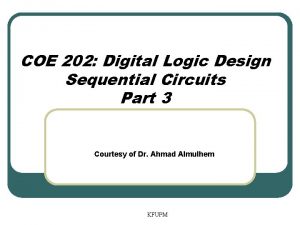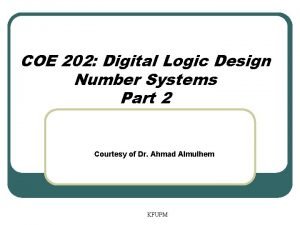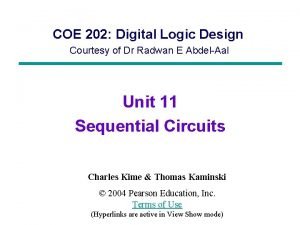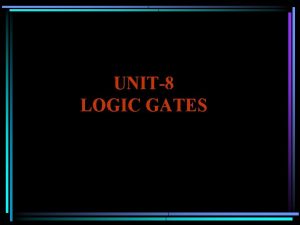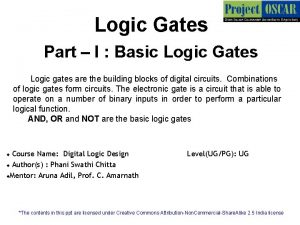Characteristics of Logic Gates COE 202 Digital Logic











- Slides: 11

Characteristics of Logic Gates COE 202 Digital Logic Design Dr. Muhamed Mudawar King Fahd University of Petroleum and Minerals

Presentation Outline v Timing Diagrams v Gate Delay and Circuit Delay v Fan-In and Fan-Out Characteristics of Logic Gates COE 202 – Digital Logic Design © Muhamed Mudawar – slide 2

Voltage Levels v Logic 1 is a range of voltage values ² NOT just a single voltage value v Logic 0 is also a range of voltages ² Not just zero volt v The voltage range between logic 0 and 1 is undefined v Digital signals are not allowed to use voltage values in the undefined range Characteristics of Logic Gates COE 202 – Digital Logic Design Logic 1 Voltage Range Undefined Voltage Range Logic 0 Voltage Range © Muhamed Mudawar – slide 3

Timing Diagram v Shows the logic values of signals in a circuit versus time v Waveform: the shape of a signal over a period of time v Example: timing diagram of an AND gate (with zero delay) x y z 0 1 1 1 1 0 0 0 1 1 1 0 1 x y z AND gate with zero delay 0 time Characteristics of Logic Gates COE 202 – Digital Logic Design © Muhamed Mudawar – slide 4

Gate Delay v A change in the inputs of a gate causes a change in its outputs v However, the change in the output signal is not instantaneous v There is a small delay between an input signal change and an output signal change, called gate delay x y z 0 1 1 1 0 0 1 1 0 0 1 z Gate delay = 1 x y 0 time Characteristics of Logic Gates COE 202 – Digital Logic Design © Muhamed Mudawar – slide 5

Propagation Delay in a Circuit v In a given circuit, each gate has a delay v The circuit has a propagation delay between inputs and outputs v The propagation delay is computed along the critical path v To compute the propagation delay, start at the inputs: 1. Delay at each gate output = Maximum input delay + Gate delay 2. Propagation delay of a circuit = maximum delay at any output Characteristics of Logic Gates COE 202 – Digital Logic Design © Muhamed Mudawar – slide 6

Computing the Maximum Circuit Delay v Consider the following circuit with 8 inputs and 2 outputs v Delay of a 2 -input AND gate = 2 ns v Delay of a 3 -input AND gate = 3 ns v Delay of a 2 -input OR gate = 2 ns v Delay of a 3 -input OR gate = 3 ns 2 ns 5 ns Compute the 3 ns Maximum Circuit Delay 8 ns 6 ns 3 ns Characteristics of Logic Gates COE 202 – Digital Logic Design © Muhamed Mudawar – slide 7

Rise-Time and Fall-Time v In logic simulators, a waveform is drawn as an ideal wave v The change from 0 to 1 (or from 1 to 0) is instantaneous v In reality, a signal has a non-zero rise-time and fall-time ² Time taken to change from 10% to 90% of High voltage (and vice versa) Ideal Wave 90% Real Wave 50% 10% Rise Time Characteristics of Logic Gates Fall Time COE 202 – Digital Logic Design Rise Time © Muhamed Mudawar – slide 8

Fan-In v The fan-in is the number of inputs to a gate v Example: a 3 -input AND gate has a Fan-in of 3 v Logic gates with a large fan-in tend to be slow v Increasing the Fan-in of a gate increases the gate delay v For example, a 3 -input AND gate has a higher delay than a 2 -input AND gate made with the same technology v Using logic gates with higher fan-in is useful when reducing the depth (number of levels) of a logic circuit Characteristics of Logic Gates COE 202 – Digital Logic Design © Muhamed Mudawar – slide 9

Fan-Out v In digital circuits, it is common for the output of one gate (called driver gate) to be connect to the inputs of several load gates v The fan-out of a gate is the number of gate inputs it can feed v There is a limit on the maximum fan-out of a gate Driver Gate a limited amount of current. 1 Each input of a load gate consumes a certain amount of current. 2 Therefore, the driver gate can only Fan-Out= 2 Load Gates The output of a driver gate can supply feed a limited number of load gates. Characteristics of Logic Gates COE 202 – Digital Logic Design © Muhamed Mudawar – slide 10

Increasing the Fan-Out with a Buffer Gate v Buffer Gate Fan-Out = N Characteristics of Logic Gates COE 202 – Digital Logic Design 2 Load Gates 1 N © Muhamed Mudawar – slide 11
